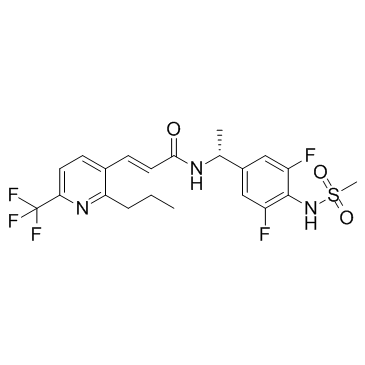1005168-10-4
| Name | PAC-14028 |
|---|---|
| Synonyms |
(2E)-N-[(1R)-1-{3,5-Difluoro-4-[(methylsulfonyl)amino]phenyl}ethyl]-3-[2-propyl-6-(trifluoromethyl)-3-pyridinyl]acrylamide
asivatrep 2-Propenamide, N-[(1R)-1-[3,5-difluoro-4-[(methylsulfonyl)amino]phenyl]ethyl]-3-[2-propyl-6-(trifluoromethyl)-3-pyridinyl]-, (2E)- MFCD28502100 3VF7K7Z10B PAC-14028 |
| Description | PAC-14028 is a potent and selective transient receptor potential vanilloid type I (TRPV1) antagonist. |
|---|---|
| Related Catalog | |
| In Vitro | PAC-14028 could prevent barrier damages, accelerate skin barrier recovery and suppress pruritus, showing a potential for the treatment of atopic dermatitis. It could suppress serum IgE increase, epidermal infiltration of inflammatory cells and mast cell degranulation associated with atopic dermatitis[1]. PAC-14028 shows efficacies against diverse disease models including visceral pain, inflammatory bowel disease, and inflammatory pain[2]. |
| In Vivo | PAC-14028 shows a plasma half-life of 2.1 h in rats while it is extended slightly to 3.8 h in minipigs. Oral bioavailability at 10 mg/kg dose is determined to be 52.7% and 64.2% in rats and minipigs, respectively suggesting that PAC-14028 is relatively well-absorbed through oral route[1]. PAC-14028 could inhibit capsaicin-evoked calcium influx in keratinocytes at sub-micromolar concentrations. This potent TRPV1 antagonistic activity in keratinocytes is manifested in vivo as the blockade of capsaicin-induced blood perfusion increase, and the accelerated barrier recovery from tape-stripping-induced barrier damages in hairless mice[3]. |
| Animal Admin | Rats: 1 mg of PAC-14028 is dissolved in 10 mL of methanol to obtain a concentration of 100 μg/mL. Male Sprague-Dawley rats/minipigs are given intravenously PAC-14028 at a single dose of 1 mg/kg, orally PAC-14028 at a single dose of 10 mg/kg as a suspension in 1% methylcellulose and 0.5% Tween80, or topically a single or multiple doses of 10 mg/kg as 1% PAC-14028 solution (gel form) in 68% PEG400 vehicle. For the topical application, dorsal area is shaved and painted with designated dose of PAC-14028 formulation. Occlusive dressing is placed on the applied region for 6 h to withhold licking or scratching the area. Blood samples are collected from the retroorbital sinus or jugular vein into heparinized tubes at designated times after drug administration. Blood samples are centrifuged immediately, and the plasma is collected and store for analysis[1]. |
| References |
| Density | 1.4±0.1 g/cm3 |
|---|---|
| Molecular Formula | C21H22F5N3O3S |
| Molecular Weight | 491.475 |
| Exact Mass | 491.130188 |
| LogP | 3.71 |
| Index of Refraction | 1.544 |
